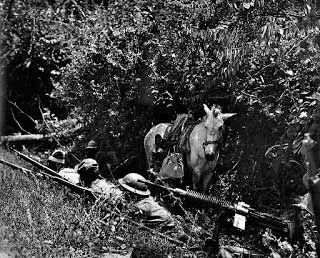Guerrilla Groups that Operated in Batangas in WWII
Guerrilla groups that were formed and operated in the years of the Japanese occupation of the Philippines from early 1942 to mid-1945 played a crucial if understated role in the subsequent return of American-led Allied Forces to liberate the country in late 1944.
The guerrillas tried to keep peace and order in the communities, disrupted Japanese communication lines, dealt with spies and other collaborators, ambushed troops of the Japanese Imperial Army and, particularly nearing the return of the Allied Forces, provided crucial intelligence information necessary for the landing of the invading Allied troops.
Guerrillas were also active in Batangas, where the Americans would land its 8th Army on the beaches of Nasugbu on the 31st of January 1945. Among the most active of these was, of course, the Hunters-ROTC group itself, which was initially formed by ex-Philippine Military Academy cadets led by one Miguel Ver in the Province of Rizal1. Initially, this group was based in and operated from the mountains of Antipolo.
Eventually, it would become among the largest guerrilla groups in Luzon with units as far north as Pangasinan and Manila, Rizal, Tayabas2, Cavite, Laguna and Batangas3 in Southern Luzon. In 1944, in anticipation of the invasion of Luzon by the US Army, the Hunter-ROTC relocated their headquarters from Tayabas to Barrio Cutad in the town of Nasugbu, Batangas4.
Another guerrilla group to have operated in Southern Luzon was Marking’s Guerrillas5, founded by one Colonel Marcus V. Agustin. The group’s presence was strongest in towns of Rizal Province such as Teresa, Morong, Binangonan, Baras and Tanay. It also had units in Manila while in Batangas, the group was known to have operated at one time or the other in the eastern section of the province.
The President Quezon’s Own Guerrillas was led by a former mayor of the town of Tiaong in Tayabas whose name was Umali. Naturally, the group’s presence was strongest in Tiaong and the neighboring towns of Candelaria as well as other towns near Mount Banahaw. In Laguna, the group was active in San Pablo and Alaminos, while in Batangas, it operated in the town of Rosario6.
Headquartered in the barrio of Arumahan in Lemery was the Gagalac Guerrilla Unit7, founded and led by one Filomeno Gagalac. This group sheltered several American US Army personnel who managed to escape from Bataan, one of whom, a Major R. S. Kramer, helped to train the group’s men8. This group would eventually be officially recognized as having been “an authorized element of the Philippine Army, serving with the Armed Forces of the United States9.”
In May 1942, another guerrilla group was formed in the western Batangas Town of Nasugbu by personnel of the USAFFE who had avoided capture by the Japanese. This group was led by one Colonel Mariano Cabarrubia, originally from Balayan but at the time a resident of Nasugbu.
This group’s early priority was to affiliate itself with another group called the Fil-American Irregular Troops organized by the American Colonel Hugh Straughn. In 1944, this group almost fell apart after several of its founders were captured and executed by the Japanese.
Cabarrubias, who was captured but was not executed because the Japanese could find no solid proof of his involvement, was released and wasted no time reviving the group initially into what would be known as the Cabarrubia Guerrilla Unit. Later, it would be renamed the Rainbow Regiment, Malakas Division of the AUSA.
The Blue Eagle Regiment, organized in 1942 by one Colonel Eduardo Alabastro, operated in Camarines, Laguna, Tayabas, and Batangas10. In Batangas, the group was headquartered in the barrio of Banilad in the town of Nasugbu11 and was under the ex-USAFFE officer Eduardo Villadolid. Like some of the other groups operating in Batangas, this group was taking instructions from Lt. Col. J. D. Vanderpool of the United States Army12.
Finally, there was the Maj. Phillips Unit under one Emilio Macabuag of Calatagan, which also operated mostly in western Batangas. This group established radio stations in Calatagan which enabled the group to establish a radio link with the United States Army for instructions regarding collecting intelligence and combat operations against the Japanese Army.
Members of this group, including Macabuag himself, would be captured and tortured by the Japanese. This did not deter the group from resuming operations after Macabuag’s release. Macabuag himself personally delivered to the US Army information “indicating Jap fortifications, positions, deployment, supplies, number of men and description of the terrain.” This group, unfortunately, was not given official recognition by the United States Army13.
2 Presently “Quezon Province,” Wikipedia.
3 “Hunters ROTC,” Wikipedia.
4 “G-1 Report,” by Eleuterio Adevoso, dated 19 November 1944, filed in Box 246, Entry 1087, Philippine Archive Collection, Record Group 407, (US) National Archives. Online at the Philippine Veterans Association Office.
5 “List of Anti-Japanese Organizations in Southern Luzon Area,” by Eleuterio Adevoso, dated 1 December 1944, filed in Box 246, Entry 1087, Philippine Archive Collection, Record Group 407, (US) National Archives. Online at the Philippine Veterans Association Office.
6 Ibid.
7 “History and Cultural Data of the Barrio of Arumahan” 1953, online at the National Library of the Philippines Digital Collections.
8 “Information Concerning the Gagalac Guerrilla Unit,” by R. S. Kramer, September 1945, File Number 278, United States National Archives, downloaded from page Gagalac Guerrilla Unit, Philippine Veteran Association Office.
9 “Recognition of Guerrilla Unit,” by R. E. Cantrell, dated May 1947, File Number 278, United States National Archives, downloaded from page Gagalac Guerrilla Unit, Philippine Veteran Association Office.
10 “Public Choice, the Life of Armand V. Fabella in Government and Education,” by Roel Landingin, published 2017 in Manila.
11 “History and Cultural Life of Banilad,” online at the National Library of the Philippines Digital Collections.
12 “Historical Data of the Municipality of Nasugbu,” online at the National Library of the Philippines Digital Collections.
13 “Memorandum for G-3, Guerilla Affairs Section, PHILRYCOM,” by Emilio Macabuag, online at the Philippine Veterans Association Office web site.

